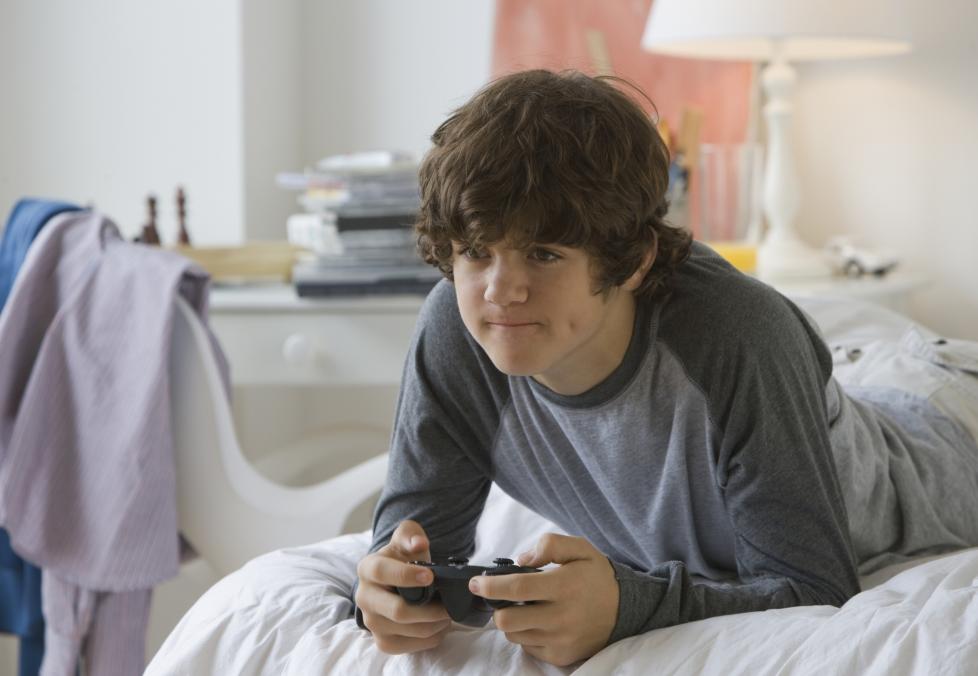
Now’s the perfect time to book an eye exam, shop for new glasses, or stock up on contact lenses.
Everything you need to know to take care of your eyes — for life.
Being glued to a screen slows blinking to a crawl, causing vision problems like dryness and eye strain. These fast fixes will get tears flowing again—no crying necessary.

If you have a teen or preteen at home, chances are you own at least one video-gaming system. You may not know how to turn the thing on, but you’ve likely quarreled with said child to “turn it off already!”
You’ve also likely wondered what all that time spent staring at a screen is doing to your child’s eyes.
Take heart. Gaming binges won’t blind your kid or cause permanent vision problems.
But (you knew it was coming)… sinking hours into video games can most definitely lead to tired, sore, red eyes, headaches—even blurry vision for a short while.
There’s actually a medical name for this uncomfortable cluster of symptoms: digital eye strain. And it’s directly tied to long stretches of looking at smartphone, TV, and computer screens, which emit high-energy visible blue light.
“Digital eye strain happens when you ask your eyes to do more than they comfortably can,” explains Memphis-based optometrist Mollie Veteto, O.D., who is with Nashville Regional Eye Care inside America’s Best Contacts & Eyeglasses.

Now’s the perfect time to book an eye exam, shop for new glasses, or stock up on contact lenses.
With video games, your child is gluing their eyes to a screen that’s close to their face and filled with blue light, lots of glare, and fast-moving action.
“It’s a lot to put your eyes through,” she says. That's especially true when you consider that more than 70 percent of kids and teens spend 2 or more hours a day on a digital device, according to The Vision Council.
Your kid won’t come to you complaining about eye strain, says Dr. Veteto, but you’ll certainly be able to spot these three telltale signs after she’s spent a couple hours or more conquering CGI foes:
Lots of eye rubbing = eye fatigue and dryness from less blinking. You don’t blink as often when you are laser focused on a screen. Blinking is necessary to keep your eye well hydrated, and some studies have found the blink rate drops by a third to half.
Reddish eyes = a sign of irritation and overuse. Eyes need frequent breaks to look at things farther away, and without the glare of the screen—not to mention with less motion to follow.
Blurred vision = another sign your young gamer’s eyes need a break. Your eyes have to work harder to see well if screens are much brighter than the surrounding light or if room light causes a glare on the screen.
Headache = time to step away from the screen. A throbbing around or behind the eyes can be a signal for eye strain.
Luckily, you don’t need to battle with your child to help them dodge eye strain. Dr. Veteto says the fixes are surprisingly simple:
Put an arm’s length (at least 18 inches) between the screen and your child’s eyes. “The closer the screen is, the more your eyes are straining,” she says.
Ideally, switch kids from playing on a smartphone or handheld unit to plugging into a TV or computer monitor—at least most of the time. Also, adjust the monitor and your child’s chair so they’ll be looking at the screen with a slightly downward gaze.
Come up with practical screen limits. There’s no set guideline from the major optometry and ophthalmology groups on recommended minutes or hours a day, but Dr. Veteto notes that eye discomfort typically sets in after 2 hours of nonstop screen use. Dr. Veteto stresses that uncorrected vision problems such as farsightedness, astigmatism, poor focusing or eye coordination abilities can drastically increase the frequency and intensity of symptoms.
“The key is moderation,” she says. When coming up with what works best for your family, take into account children’s ages, their other activities and interests, and how much of their school work and homework involves computer work.
Encourage water and bathroom breaks. Even if you’ve cleared your child to play for an hour or more, remember that everyone benefits from quick screen breaks every 20 minutes. The idea is to look away from your screen—ideally at something 20 feet away—for 20 seconds to let your eyes reset.
If a hard stop at 20 minutes means your child gets eliminated in the game or would force their squad to lose a battle, frame breaks in terms of number of rounds played or points scored. For some perspective, rounds of the popular “Fortnite” video game typically last anywhere from five to 20 minutes.
Admittedly, this tip requires extra involvement on your part until your child’s gotten into the habit of pausing every round or two. In the case of “Fortnite,” you can always encourage more dance breaks!
Digital eye strain is temporary, but if you’ve committed to these steps and your child is still having problems with red, dry eyes, headaches, or blurry vision, call a doctor to have their eyes checked.